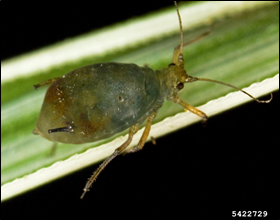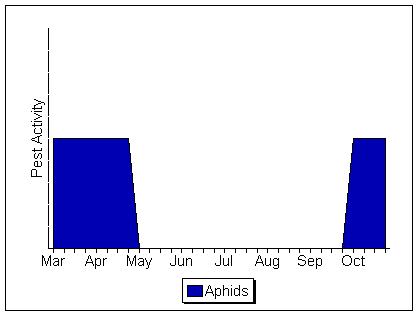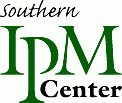Aphids in Wheat
Aphids
Description

Oat bird-cherry aphid
David Cappaert, Michigan State, Bugwood.org
Aphids are small, soft-bodied, pear-shaped insects. Their piercing-sucking mouthparts look like a small tube arising from under the head. They will vary in color from green to blue to yellow.
Corn leaf aphids and bird cherry oat aphids are very common in the fall while English grain aphids are most abundant in the spring. Currently the Russian wheat aphid and yellow sugarcane aphid are not present in Kentucky. Aphids--adults and nymphs--can damage plants anytime after emergence.
Damage
Feeding by aphids commonly found in Kentucky may cause two types of damage: 1) Plants may be damaged by aphids feeding on the plant and 2)damage may result from the aphids moving a plant virus, primarily Barley Yellow Dwarf Virus, into the plants. Any species of aphid can carry the Barley Yellow Dwarf Virus, but the bird cherry oat aphid is the most important vector. Large numbers of aphids can reduce stands during late fall and early spring or cause kernels to shrivel during late spring and early summer.
Aphid Activity in Wheat

Please note: These dates are approximations only. This calendar was constructed using data from Kentucky, USA. These dates may not apply in your area. You may wish to contact your county extension agent or agricultural consultant for information tailored to your locality.
IPM Techniques and Scouting Procedures
Scouting is recommended in the fall and in the spring before leaf emergence. The number of sites you need to examine in a field is based on the size of the field.
- At each location examine three one-foot lengths of row.
- Count the total number of aphids present in each one-foot length. For each plant in the sample, be sure to check the entire plant, especially near the soil line.
- You will want to record the average number of aphids per foot of row found at each scouting site.
- In the fall and during a warm winter (before Feekes growth stage 4), when trying to reduce risk of Barley Yellow Dwarf virus (BYDV) loss, consider an insecticide application if aphid populations meet or exceed the following:

- Insecticide applications are not recommended at Feekes growth stage 4 or later.
In the Spring, after heads have emerged, at each location examine 10 heads for the presence of aphids.
- From the following chart, record a rating of infestation based on the number of aphids per plant.

- In the spring during "headfilling" when using the rating scale for aphid damage, a control should be considered if an average rating of 2-Moderate (50 - 100 aphids per foot of row) or greater is recorded.
References and Additional Information
- IPM -4 Kentucky IPM Manual for Small Grains
- ENTFACT 121 - Aphids and Barley Yellow Dwarf on Kentucky Grown Wheat


